As noted last week, I spent the week spanning New Year’s Eve in the enchanted isles of the Galapagos. The previous week (over Christmas) my family and I were in coastal Ecuador. I saw a total of three species of iguanas in the two locations, and they offer a neat little story of evolution. Let’s take a look.
First, let’s introduce the key players:
The green iguana, Iguana iguana
(coastal Ecuador, and many other places around the tropical Americas):

The land iguana, Conolophus subcristatus
(Galapagos only, in low-elevation inland locations where there are plants growing):

The marine iguana, Amblyrhynchus cristatus
(Galapagos only, along the shorelines):
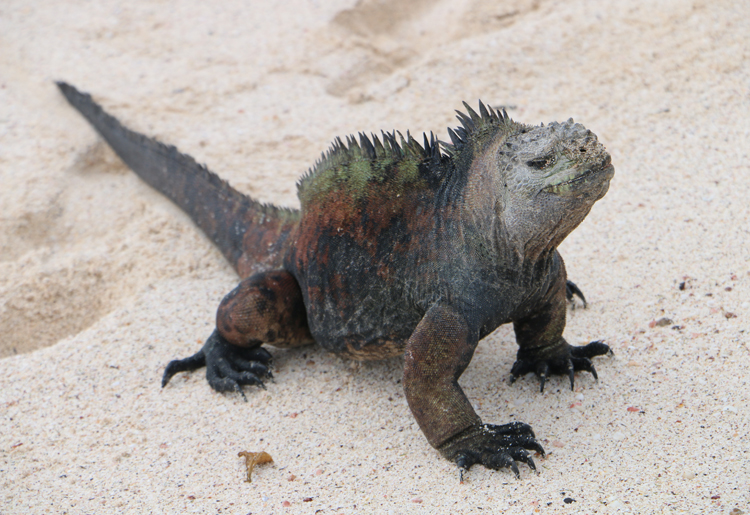
What do these three species have in common? What differentiates them? What lessons do they have to teach us?
The green iguana likes trees, as you’ll see here:



It is a vegetarian, eating leaves and according to my observations, seems to especially enjoy hibiscus flowers!

Now let’s journey a thousand kilometers to the west, and examine the two species of iguana that are only found in the Galapagos Islands. The islands are of volcanic origin, and have never been connected to any continent. We think they have been formed (and continue to be) due to a volcanic “hotspot.” Like Hawai’i, they show an age progression – youngest in the west (closest to the East Pacific rise, where the Nazca plate is being formed through seafloor spreading) and older to the east (headed toward the subduction zone that has helped build the Andes on the western margin of the South American plate and continent).
We begin with the land iguana, which is most similar in lifestyle to the green iguana in that it lives 100% of its time on the land, and eats arboreal vegetation.

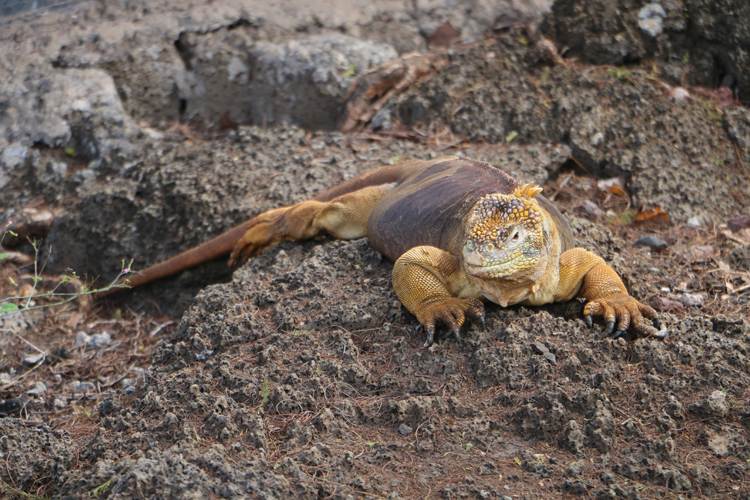
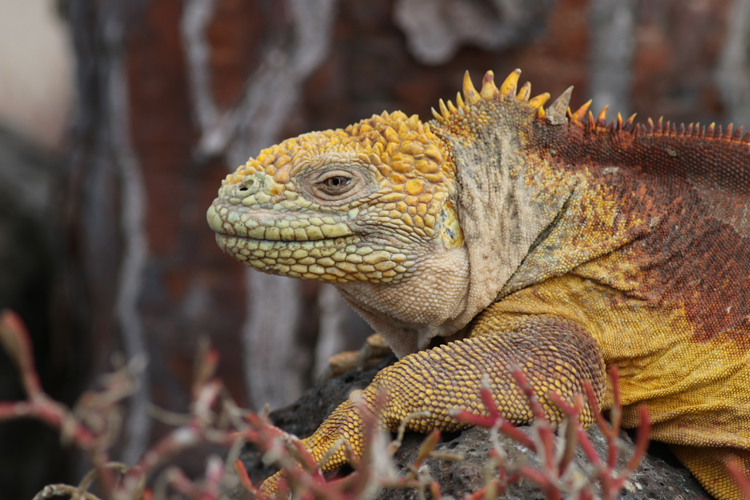
The differences in color and proportions are apparent at a glance.
What’s not necessarily apparent is that the land iguanas of the Galapagos don’t climb. Their ancestors gave up the arboreal acrobatics we see in the green iguana, and instead confine themselves to the ground in the dry lowlands of several of the main islands (though not others, as I discuss in a separate post).

That’s a bit of an issue, since this is what they eat:
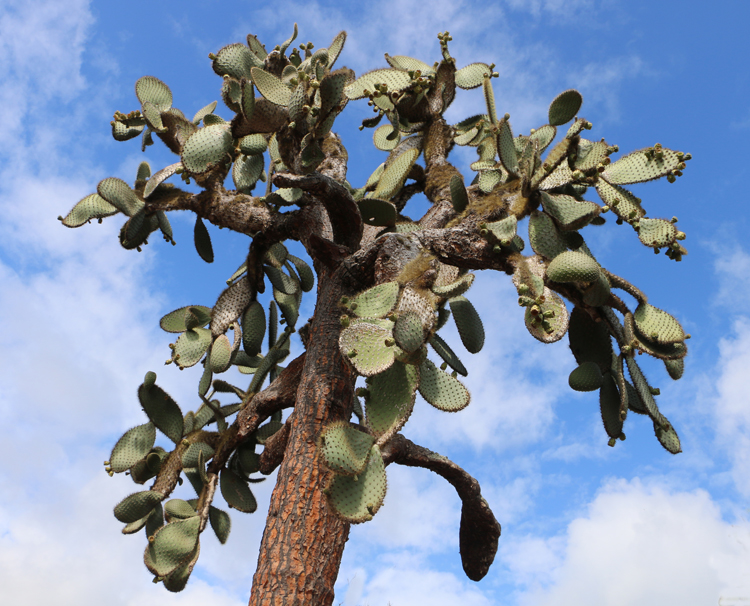
That’s a prickly pear cactus (Opuntia). It makes up about 80% of their diet, though they’ll eat other vegetation, and have been documented opportunistically eating bugs and carrion, too. In the mature prickly pear, there can often be a significant vertical distance between the ground and the delectable fleshy paddles and fruit, as my wife Lily here demonstrates:
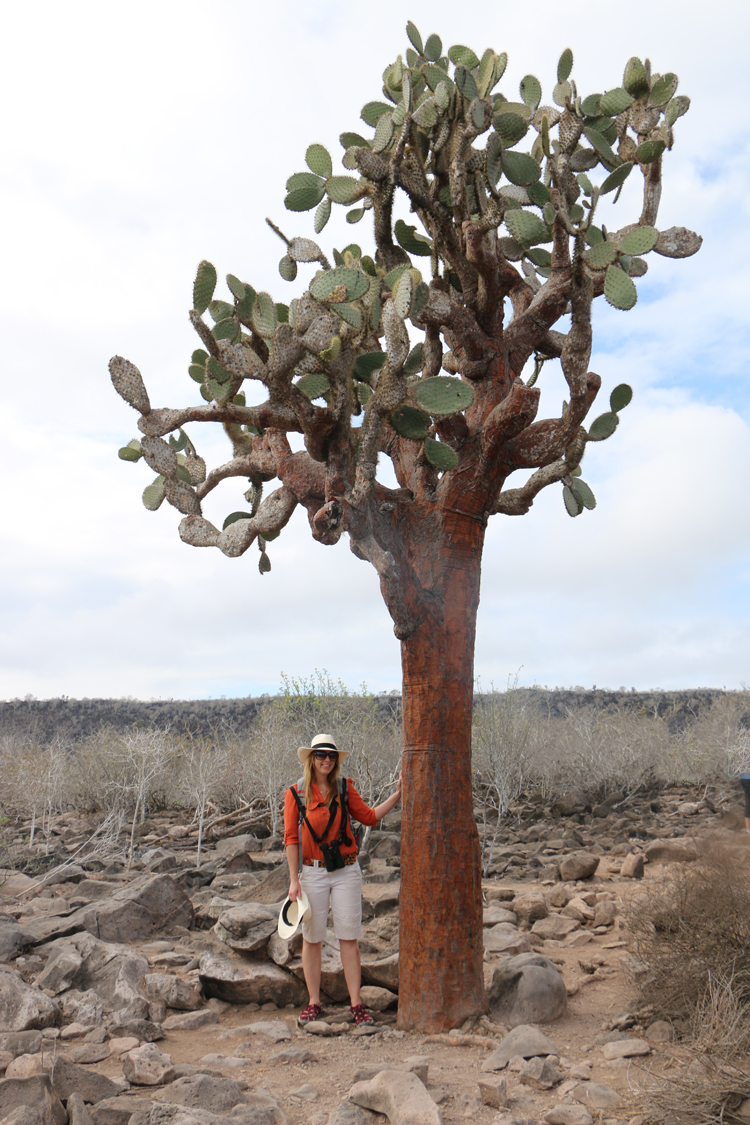
So the land iguanas have to either resign themselves to shorter, younger cactus, or to the chunks that fall due to being undermined by the vandalism of the cactus finch, which can fly to the upper part of the cactus and then jab its massive beak repeatedly into the flesh:
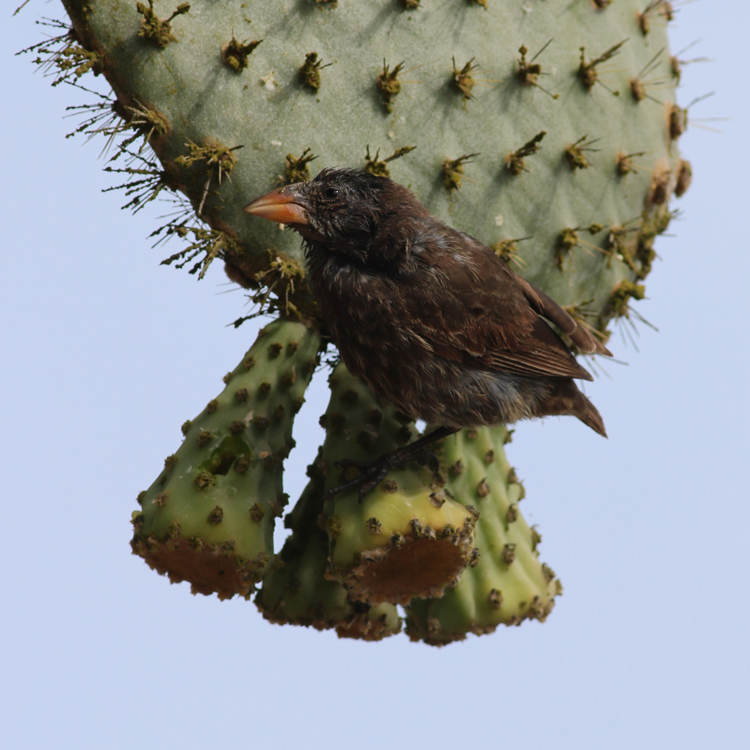
This “bird-on-plant” violence likely generates some airborne leavings which gravity delivers to the lower levels of the ecosystem….
As a result, this land iguana seems to be saying, “Yum; thanks!”

They are handsome beasts. I regret the fact that these photos lack a sense of scale, but this individual for example is over a meter long:
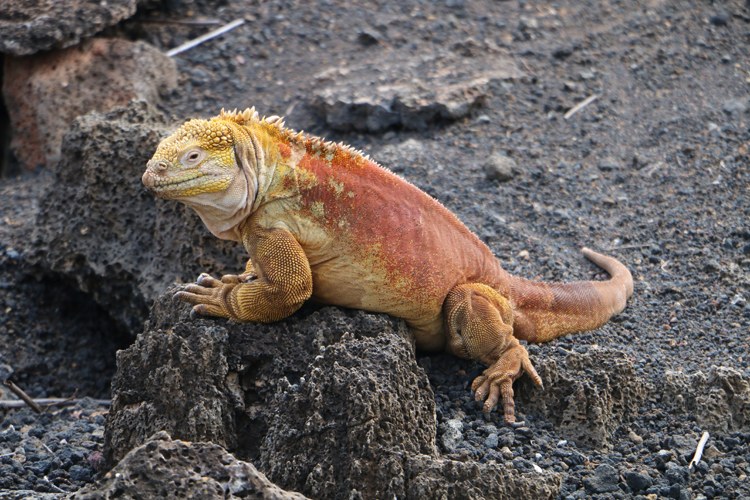
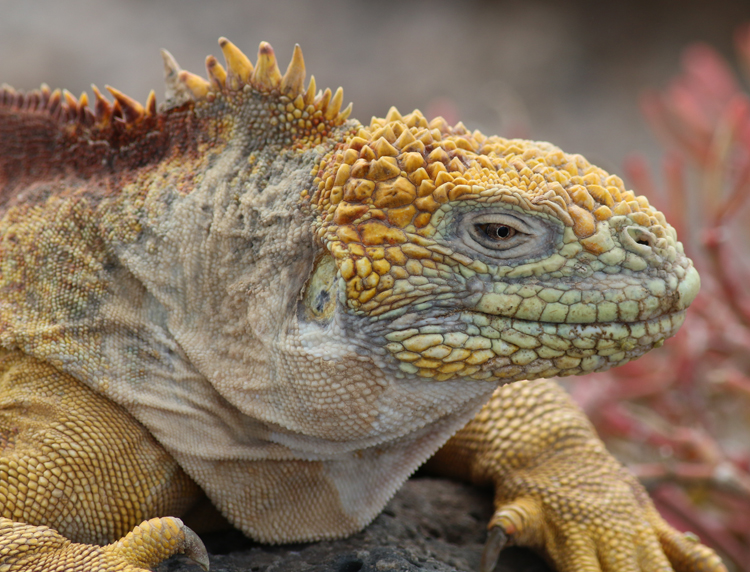


The marine iguana is also a vegetarian, but with a twist: unique among modern lizards, it forages for its food in the sea! They have long, sharp claws that aid in clinging to rocks on shore, battered by waves, or underwater in powerful currents. In the water (for the big males) or in the intertidal zone (for the smaller individuals), they eat algae.

They are most often dark gray, which not only provides camouflage on the basalt of the islands’ coasts, but also due to its low albedo, helps them regain functional temperatures after being immersed in the water surrounding the islands, which is quite cold due to the Humboldt Current. Their heads often have a grayish tonsure, as salt crystallizes there, expelled through the nostrils in audible blasts by special glands that clean their blood of excess salt ingested during feeding. Their tails are relatively bladelike (laterally compressed, relatively vertically extended) so that, swept from side to side, they are useful for submarine locomotion, like the tail of a fish.

Most of the marine iguanas I observed spent a lot of time just lazing about, soaking up the rays:

Darwin found their appearance repellent, but I think they have a certain pug-like dignity to them.
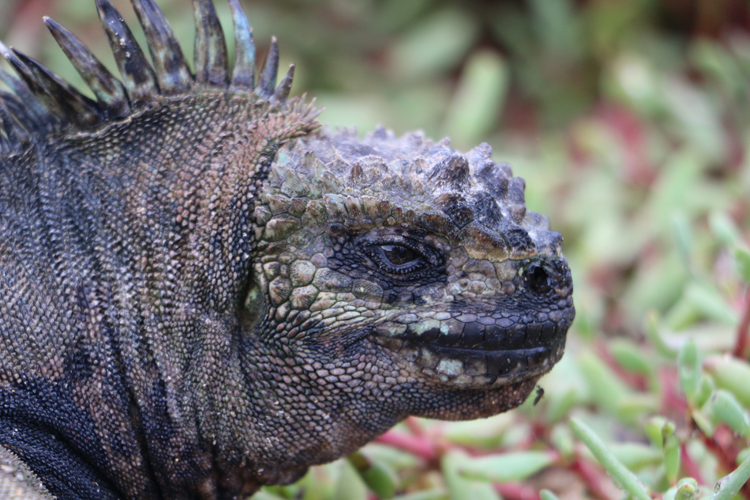
My wife thought so, too. Here she is conversing with a rapt trio of them:

…Though they don’t appear impressed with what she has to say:

Several had alternative colorations that reminded me of forest camouflage, as deer hunters wear in the Appalachians each fall:


On Española Island, the marine iguanas have a distinctive “Christmas tree” color scheme of “red” and “green.”
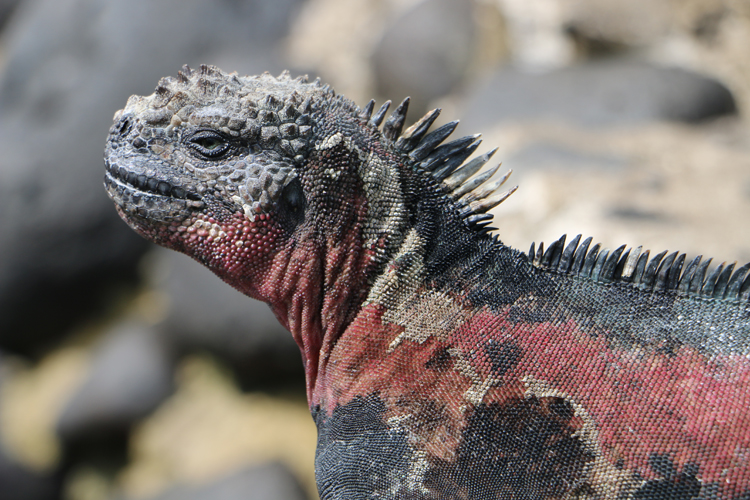
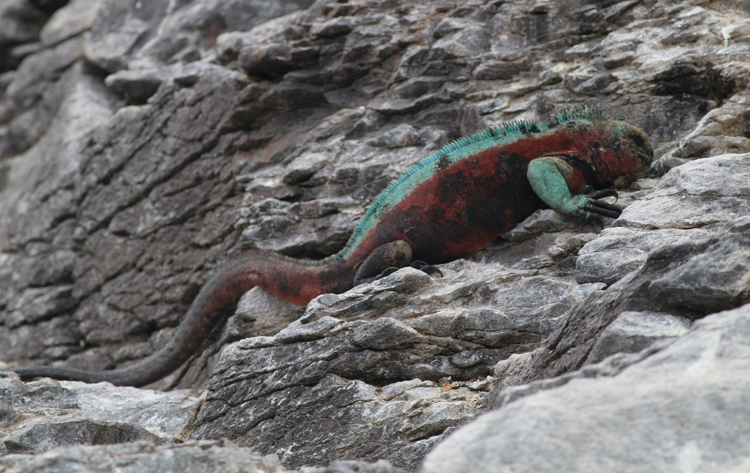
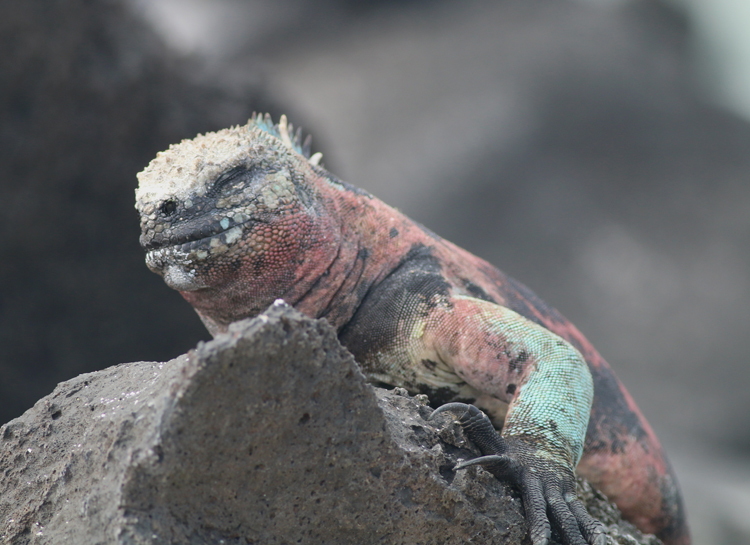
Clearly, if the interpretation that the prevailing dark gray coloration is an adaption for heating up or camouflage on lava flows, then one of those variables doesn’t apply as acutely on Española as elsewhere. Or else an additional variable applies on Española Island that isn’t manifested as acutely elsewhere, overwhelming the influence of the previous variables, or perhaps sexual selection is more important among Española marine iguanas? Anyhow, they are gorgeous looking little demons:

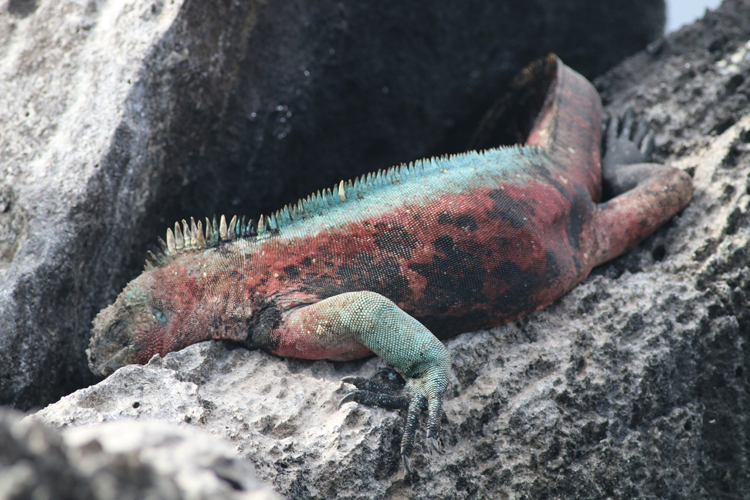
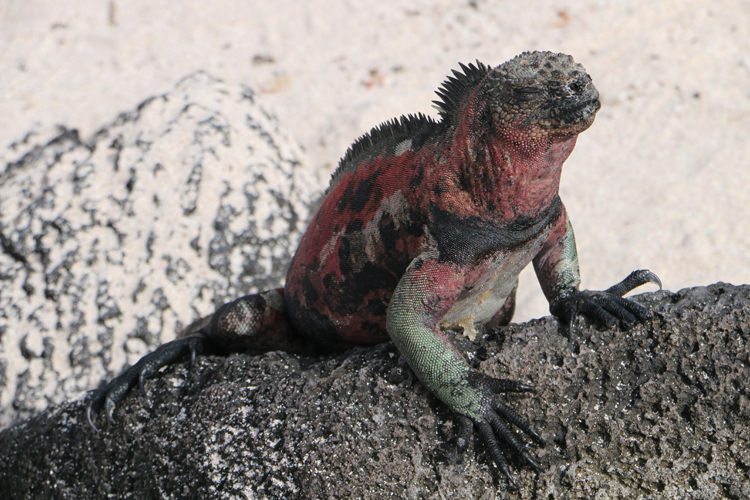
There’s also a pink iguana in the Galapagos, but it’s only on a single remote island (Wolf) and has less than 100 individuals in the population, so I didn’t get to see that. It’s most closely related to the land iguana.
How are these species (actually genera!) related? They are all descended from a common ancestor iguana. The two Galapagos species represent a clade, a group of more related species, while the green iguana is more distantly related.
Using molecular genetics (comparing parts of their DNA sequences), Rasmann (1997) estimated the age of divergence between the Galapagos marine and land iguanas at ~10 Ma, which is significant because that’s more than double the age of the oldest islands in the archipelago. Assuming there was only 1 ancestral iguana population* that washed ashore on the archipelago, it implies that landing and the subsequent divergence took place on an island that no longer exists, now sunk (+ eroded) out of sight to the east, and that the lizards have used the Galapagos Islands as stepping stones, hopping to the west and colonizing as new islands emerge from the seafloor in the west, abandoning the older ones to the east (or alternatively, going down with the ship).
* “population” here would mean at the very least 1 pregnant female, and perhaps upwards to 1 female and 1 male, or multiple individuals.
So the implication would be something like this:
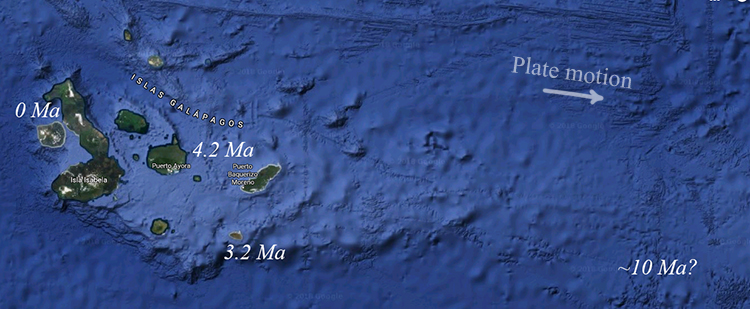
More recently, MacLeod, et al. (2015) also made an estimate of the divergence between not only these two groups but also included related lizards, including the genus of the green iguana. I present a modified form of their Figure 1 below:
Note the red lines I’ve added, which show the land and marine iguanas diverging much more recently, ~4.5 Ma (shorter red line to the right; this is about the age of the oldest igneous rocks on the oldest islands in the archipelago), and the last common ancestor of green iguanas, land iguanas, and marine iguanas as existing ~14 Ma (larger red line to the left). Note also that the green iguana (Iguana) is not the most closely related group of living lizards to the Galapagos clade (i.e., Conolophus + Amblyrhynchus). Instead, that honor falls to the spinytail iguanas, Ctenosaura.
Okay, that’s probably enough for one post… I think it’s time to…

References cited:
Amy MacLeod, Ariel Rodríguez, Miguel Vence , Pablo Orozco-terWengel , Carolina García, Fritz Trillmich , Gabriele Gentile, Adalgisa Caccone, Galo Quezada, and Sebastian Steinfartz. “Hybridization masks speciation in the evolutionary history of the Galápagos marine iguana,” Proceedings of the Royal Society B; 22 June 2015. https://doi.org/10.1098/rspb.2015.0425
Kornelia Rassmann, “Evolutionary Age of the Galápagos Iguanas Predates the Age of the Present Galápagos Islands,”
Molecular Phylogenetics and Evolution; Volume 7, Issue 2; 1997, Pages 158-172. https://doi.org/10.1006/mpev.1996.0386.

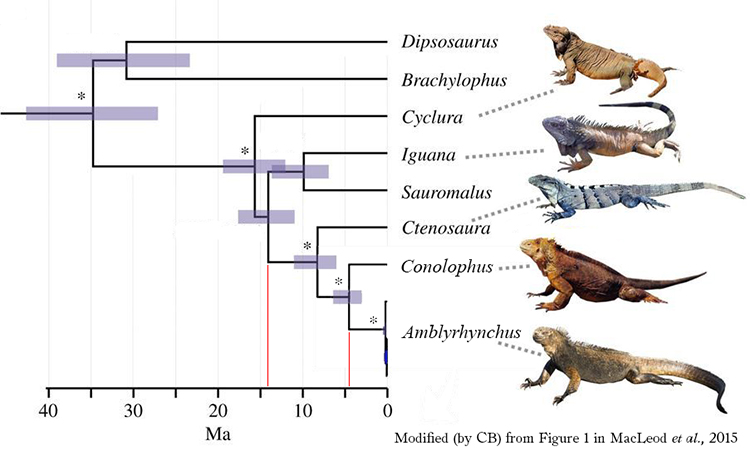
Great post and lovely photos. Thanks for doing the research on the evolutionary tree.
From the photo of your wife, they seem to have little or no fear of humans. When I visited Anrarctica, one could walk right through a penguin colony and they hardly noticed.
Yeah, that was the most astonishing thing about the Galapagos – there was no fear in these animals. The crabs were wary, but everything else seemed pretty much completely relaxed around humans. It was magical.
Love these pics thank you, it’s brilliant to see such close ups and these animals are all beautiful! Truly amazing creatures. They seem to have great character about them, some made me chuckle. Lovely.
Great photos. The character of the iguanas really comes through. I feel like I just took a field trip to visit prehistoric animals. Also really cool to see the size of that Opuntia. My potted version in no way foretold the size it would grow in the wild.